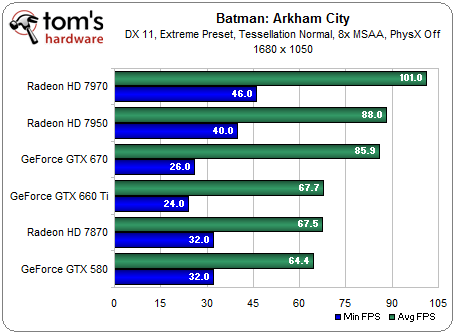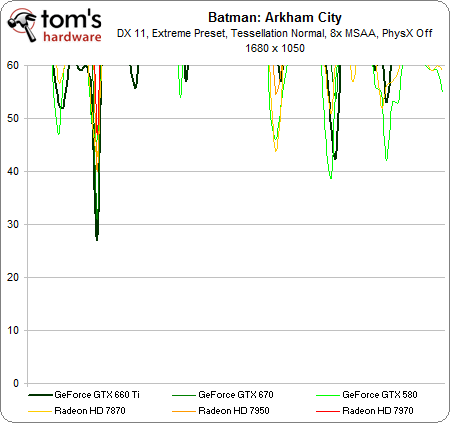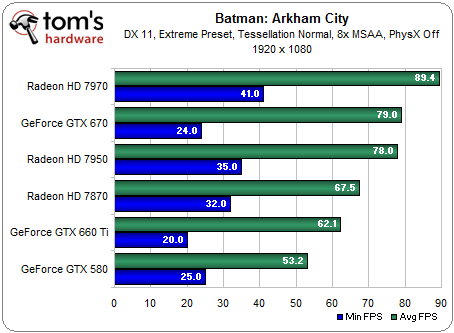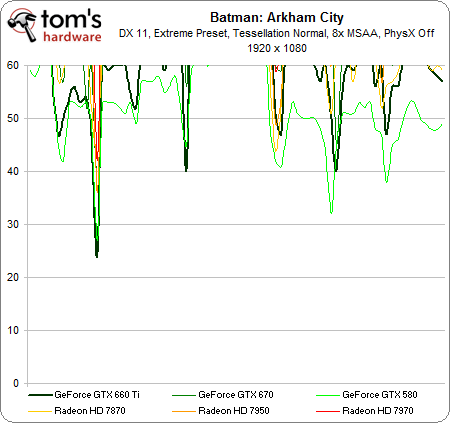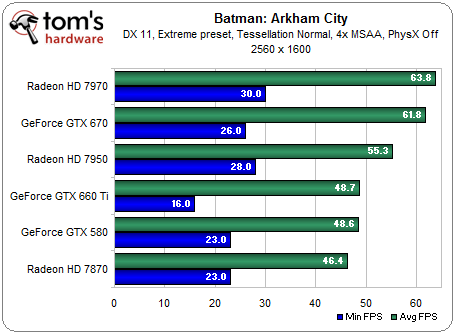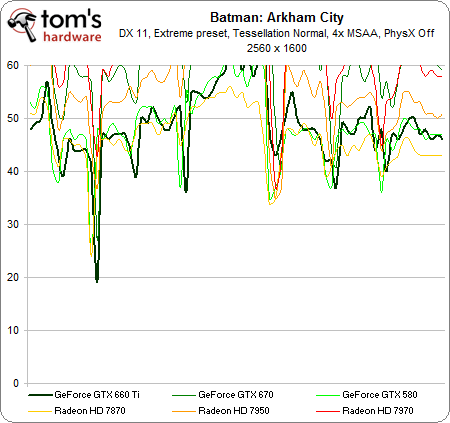GeForce GTX 660 Ti Review: Nvidia's Trickle-Down Keplernomics
Nvidia's Kepler architecture is finally manifest in a $300 graphics card, which the company says beats AMD's Radeon HD 7870 and challenges its more expensive 7950. Can this GK104-based mainstream card carve out a spot between the GCN-based competition?
Benchmark Results: Batman: Arkham City
Starting at 1680x1050, Nvidia's GeForce GTX 660 Ti easily handles the Extreme detail preset with 8x MSAA enabled. We set tessellation level to Normal because there's little advantage to setting it any higher. Also, we disable PhysX to keep our results comparable (though it's worth noting that turning PhysX on gives the GeForce cards a visual advantage in certain areas of the game that AMD's boards can't match).
There's a frame rate drop at the beginning of the benchmark, but that's a glitch that occurs when the test switches between scenes. Thus, none of these solutions drop below 40 FPS during the part of the test that represents game play.
The same performance dip affects 1920x1080, but only Nvidia's GeForce GTX 580 is forced below 40 FPS during the rendered part of the test. All of the cards we're testing perform well, and although the Radeon HD 7870 and GeForce GTX 660 Ti are clearly competitors, the 7870 takes a measurable lead. The GeForce GTX 670 and Radeon HD 7950 perform similarly, and the Radeon HD 7970 leads.
In order to realize playable performance at 2560x1600, we had to drop multi-sample anti-aliasing to 4x, leaving tessellation at Normal and detail preset at Extreme. Ignoring the dip we see yet again, all three Radeons and Nvidia's GeForce GTX 580 suffer a slight drop to about 35 FPS at one point in the benchmark.
The settings we used for testing are very important. Nvidia's marketing material shows the GeForce GTX 660 Ti with a notable lead in Batman: Arkham Asylum. Indeed, when we used the same settings, the GTX 660 Ti beat AMD's Radeon HD 7870 by a margin of 84.5 to 76.7 FPS. Just remember that differences in architecture, memory bandwidth, and clock rates favor certain benchmark configurations. We picked our visual output to deliberately maximize what you can get from Nvidia's newest card, and we're quite comfortable with the combination of quality and performance.
Get Tom's Hardware's best news and in-depth reviews, straight to your inbox.
Current page: Benchmark Results: Batman: Arkham City
Prev Page Test Setup And Benchmarks Next Page Benchmark Results: Battlefield 3Don Woligroski was a former senior hardware editor for Tom's Hardware. He has covered a wide range of PC hardware topics, including CPUs, GPUs, system building, and emerging technologies.
-
game junky Hmm. I have been wanting to replace my 560 - this throws a wrench in the gears. I was sold on a ASUS 670 but I think I'll wait to compare specs with their 660ti - I just started ripping my BD collection so the additional RAM bandwidth might be worth the extra $100 but it is still an interesting option.Reply -
crisan_tiberiu so, this is basically a card that costs 40$ less then a GTX 580, consumes 100W less power then a gtx 580 and its 8% better...hmm, intresting.Reply -
rmpumper That's strange - on techpowerup review the 660Ti is above 7950's average performance.Reply -
outlw6669 game junkyI was sold on a ASUS 670 but I think I'll wait to compare specs with their 660ti.Asus' DCU2 Top ends up about 5% faster than stock, 8% slower than stock GTX 670 and still uses that excellent cooler.Reply
http://www.techpowerup.com/reviews/ASUS/GeForce_GTX_660_Ti_Direct_Cu_II/1.html
Still, the GTX 660Ti looks to be a decent card.
Not really fond of how nVidia keeps nerfing their memory bandwidth though.
Once prices drop a little, I could see it being an excellent mainstream card. -
verbalizer nice card, not OVERLY impressed...Reply
BUT THE PRICE...!
c'mon SON let's be real here......
ridiculous @ $300 beans.. -
felipetga I have been holding to upgrade my GTX 460 256bits. I wonder if this card will be bottlenecked by my C2Q 9550 @ 3.6ghz....Reply -
verbalizer GPGPU = Kepler = FAIL....Reply
that's depressing but I understand nVidia has designated GTX 6 series as a gaming cards but c'mon SON.!!!
ridiculous once again.. -
EzioAs Clearly we need more price cuts on the 660ti. I expect AMD to lower the prices even more, heck online retailers sell Radeon cards lower than the MSRP, making 7950 and 7870 even more budget friendly. It's still sad really to see mid-range cards battling at $300+. It used to be $250 and lowerReply
